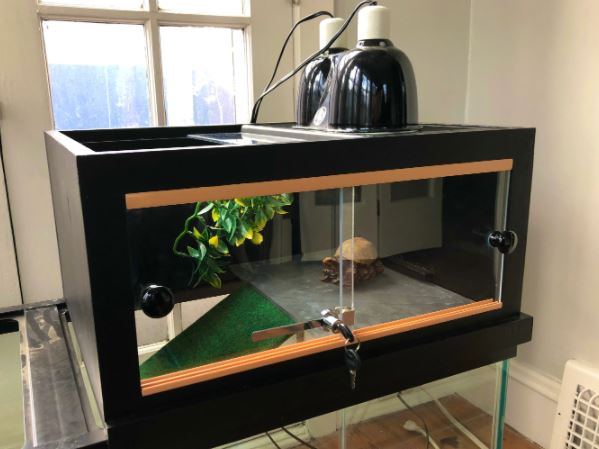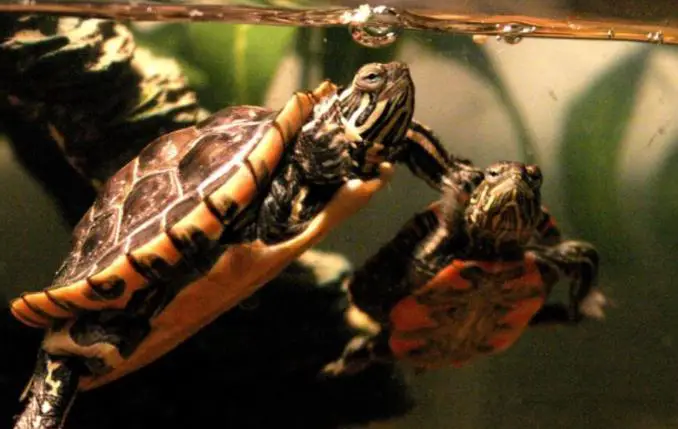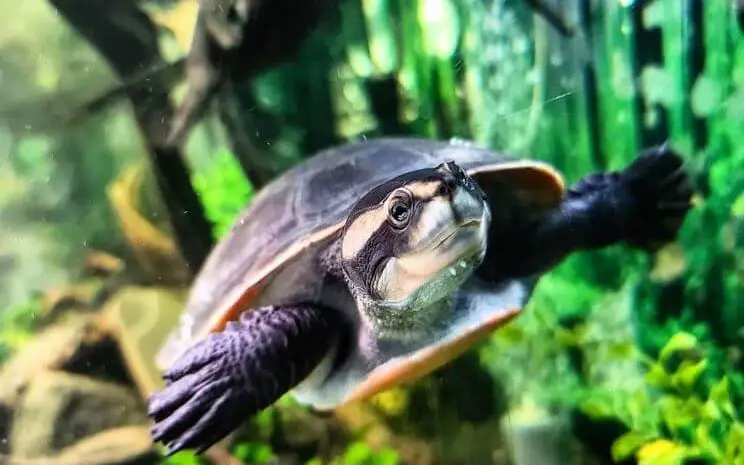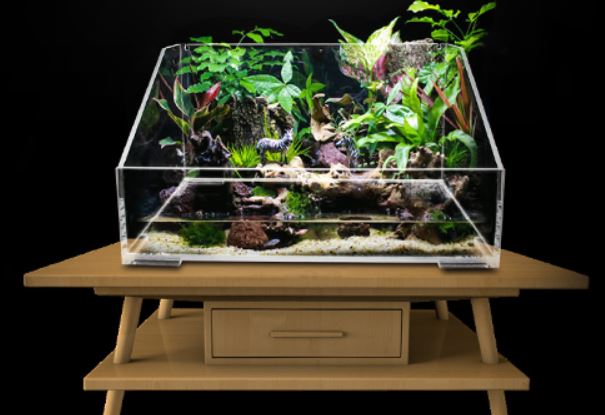Can I put a heating pad under my turtle tank?
If you are looking for a way to keep your turtle’s tank warm, then the answer is no. You can’t use a heating pad under your turtle tank.
So, if you want to keep your little guy cozy this winter, don’t try this DIY method.
Turtle tanks need to stay at an ambient temperature of between 65 and 80 degrees Fahrenheit.
Good thing, there are safer ways to do it than putting a heating pad under the tank, such as by using a heat lamp!
Related Posts:
- Best Plants for Bearded Dragons You Should Know
- 7 Best Heat Lamps for Tortoise
- Top 7 Best UVB Bulbs for a Sulcata Tortoise
- Best Heat Mat for Leopard Gecko
Can I Put a Heating Pad Under My Turtle Tank?
You can’t put a heating pad under a turtle tank. Turtles have thin plastrons, so they are highly sensitive to heat through their carapaces.
They feel it through the carapace. Devices that are used may overheat and burn.
The safest way to raise the temperature is by using a basking lamp and overhead ceramic heat emitter.
With these, you can regulate the temperature gradient so turtles can move around and get away from the high-temperature areas if they need to.
Reptiles should also be allowed 10 to 12 hours of darkness every night.
If you do not use lights, you will need to be more vigilant about the turtles staying on the correct side of their terrarium.
You can also use a thermometer (such as those made for aquariums) near the basking area. Make sure that the basking area reaches at least 80 to 85 degrees Fahrenheit during this vulnerable time of year.
What Are the Temperature Requirements in a Turtle Tank?
Typically, the water temperature for turtle tanks should be set at 75 degrees Fahrenheit during the day.
At night, it can drop to somewhere between 65 to 70 degrees Fahrenheit.
Aquarium heaters are never 100% accurate in their readings all of the time since they are measuring something in motion (the water).
They work best when there is little to no flow within the tank.

What Temperature Is Needed for a Red-eared Slider?
Turtles, including red-eared sliders, should be kept in temperatures between 65 and 80 degrees Fahrenheit.
If you live in a very warm climate where it stays around 90 to 95 degrees Fahrenheit, your turtles will need lots of shade and water misting with cold water every day.
The same goes for turtles in very cold climates.
They will need to be kept in an area where the room temperature is no lower than 60 degrees Fahrenheit.
How Do You Increase Water Temperature for Turtles?
You can get a submersible heater or even a basking lamp that has a built-in heating element.
If you want to raise the temperature very quickly, the basking lamp is going to be the easiest to use.
Just make sure that you use ceramic heat emitters or other devices besides a light bulb as turtles often get burned from light bulbs.
Basking lamps should not be used as a method of raising a turtle’s temperature throughout its entire enclosure.
It should only be used as a heat source in the basking area.
It is best to keep the water temperature constant, so use an aquarium heater than any kind of light bulb heater.
A good range for your turtle tank would be 78 to 82 degrees Fahrenheit during the day and around 70 to 75 degrees Fahrenheit at night.
How to Keep a Turtle Warm Without a Heat Lamp?
A heat lamp can be used, but it also increases the ambient air temperature.
Turtles like to bask and need a way to raise their body temperature (and water with a basking spot) and then they need a way for that warmth to dissipate into their environment.
A light-colored or white surface will help reflect that heat back into the air.
Do Turtles Need a Water Heater?
Turtles are cold-blooded. You need to provide them with some form of heat.
They will become sluggish if they don’t have anything to keep them warm. And if it gets too chilly, they may even perish.
A water heater and basking heat are required for aquatic turtles.

Can You Use a Heat Bulb for a Turtle?
Yes, but it must be kept on one side of the enclosure and not touch anything.
If it touches anything, that spot will become very hot and could burn your turtle.
Heat bulbs should never be used as a primary heat source because they dry out the air in the habitat quite quickly.
Do Turtles Get Cold at Night?
Yes. Turtles need to be kept in an area where the room temperature is no lower than 60 degrees Fahrenheit at night.
A heat lamp or a light bulb may also help provide some warmth, but it should always be used in conjunction with a basking spot so that your turtle can move closer to, or further away from, the heat source as needed.

How Much Does a Turtle Tank Heater Cost?
Aquarium heaters can be purchased at most pet stores and can range in price from $10 to over $100.
They usually come with the necessary fixtures for installation into an aquarium or can be used in a sump-type system if you have one available.
There are also heaters that are designed to fit into your wall socket, which plugs into an outdoor timer.
Do Turtles Get Cold in the Winter?
Adult turtles are unable to withstand freezing temperatures. They are unable to endure having ice crystals in their tissues.
This is the reason why they hibernate in winter. This also gives their body a chance to replenish its energy reserves.
When they wake up during that time, they will be defenseless against predators.
They have trouble being in the cold because they are ectotherms, so their bodies actually depend on heat (i.e., the sun).
If turtles go into hypothermia (which can be common), they may stop eating or become lethargic and eventually die.
They aren’t able to produce their own heat or adjust their body temperatures.
Lack of heating is one of the most common problems for keeping turtles as pets. Turtles need a constant steady temperature as they are cold-blooded animals.
In captivity, they can’t regulate their own temperatures, so it’s important that we do it for them.
Conclusion
Can you put a heating pad under a turtle tank? The short answer is no. You should not put a heating pad under your turtle tank.
Turtles are cold-blooded and need to be hot in order for them to digest food properly and regulate their body temperature.
If the heat source does not get below the glass of the terrarium or aquarium, it will not help your pet feel any warmer at all.
You may want to invest in an infrared lamp if you live somewhere where winters can get very cold such as Canada or Alaska!
Key reminders on how to keep your turtle water warm:
1. Tank Heater:
- Submersible Aquarium Heater: Invest in a submersible heater designed for aquariums. Choose one appropriate for your tank size and ensure it’s specifically designed for use in water.
- Temperature Control: Set the heater to maintain the water temperature within the recommended range for your turtle species. For most turtles, the ideal water temperature is between 75°F to 85°F (24°C to 29°C).
2. Proper Placement:
- Substrate Placement: Place the heater at a location where it won’t come in direct contact with the substrate or decorations to prevent damage.
- Water Circulation: Position the heater near a filter output or in an area with good water circulation to ensure even heat distribution.
3. Thermometer Monitoring:
- Quality Thermometer: Use a reliable aquarium thermometer to monitor the water temperature consistently.
- Regular Checks: Check the thermometer regularly to ensure the heater is maintaining the desired water temperature.
4. Ambient Room Temperature:
- Room Climate: Maintain a suitable room temperature to support the aquarium heater in maintaining the water temperature. Avoid placing the tank in areas with extreme temperature fluctuations.
5. Additional Heating Methods:
- Basking Area: Ensure the basking spot receives ample warmth from a basking light or heat lamp, as turtles often regulate their body temperature by basking.
- Heated Rocks or Tiles: Placing heated rocks or tiles under the basking area can supplement warmth for your turtle.
6. Insulating Tank Cover:
- Tank Cover: Use a tank cover to reduce heat loss from the water’s surface. This helps retain warmth and stabilizes the overall tank temperature.
7. Regular Maintenance:
- Cleanliness: Maintain cleanliness in the tank, as debris can interfere with the heater’s effectiveness.
- Heater Inspections: Periodically check the heater for any signs of damage or malfunction. Replace or repair as necessary.
8. Seasonal Adjustments:
- Winter Adjustments: In colder seasons, the room temperature might drop, requiring an adjustment in the heater’s settings to maintain the desired water temperature.
- Summer Considerations: In warmer weather, keep an eye on the tank temperature to prevent overheating. Consider slightly reducing the heater’s settings if needed.
Ensuring a consistently warm water environment is crucial for the health and well-being of your turtle. Employing a suitable heater, monitoring temperatures, and providing supplementary heating methods where necessary will create a comfortable and stable aquatic habitat for your pet turtle. Regular checks and adjustments based on seasonal changes will help maintain optimal conditions for their health and activity.
Further Reading:
- 7 Best Lighting for Chameleons
- 9 Best Heat Lamps for Bearded Dragons
- 5 Best Bearded Dragon Lighting Setups
- Best UVB Bulb for Sulcata Tortoise


